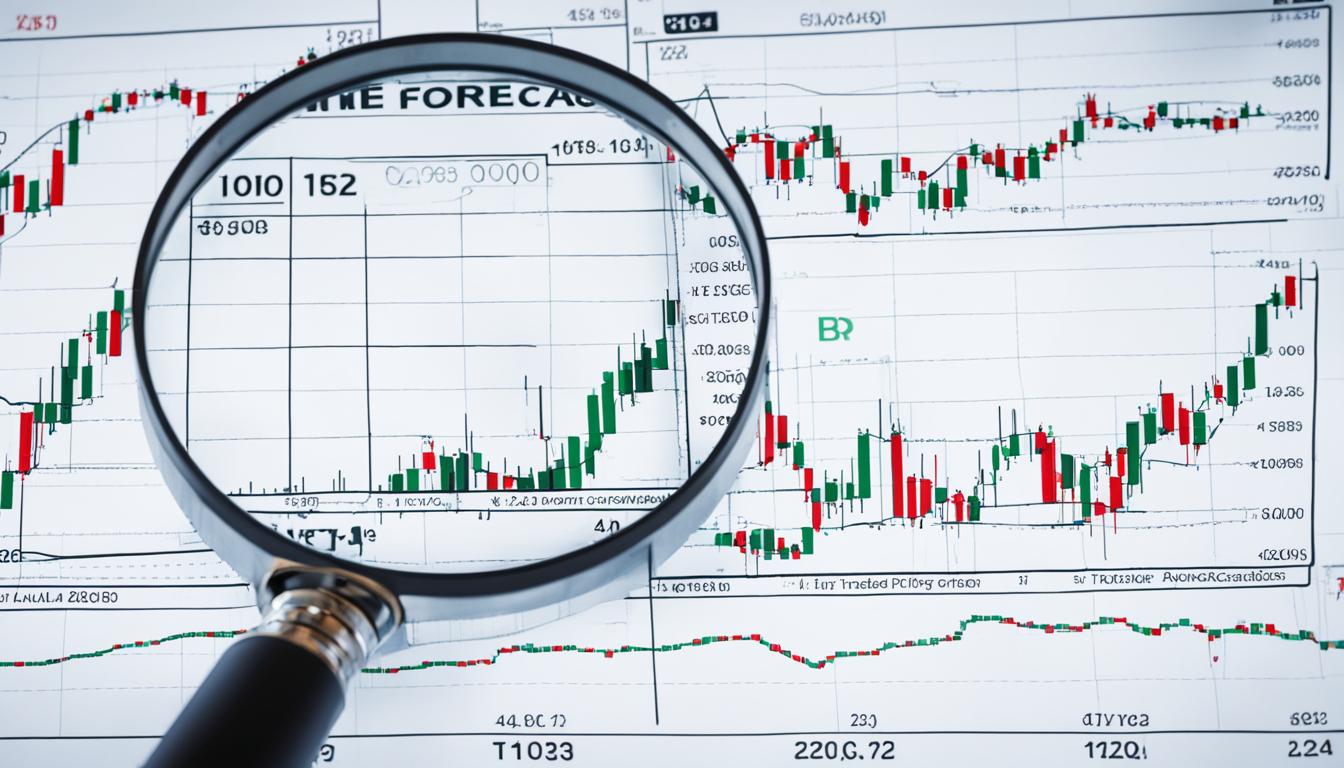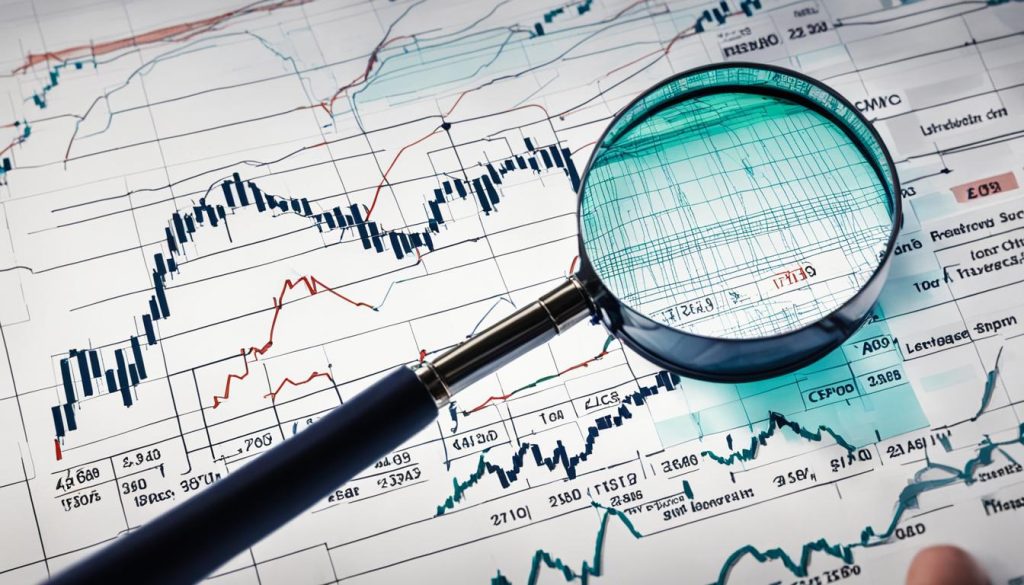As the global forex market continues to expand, the concept of leverage in forex trading emerges as a central pillar of currency exchange strategizing. Characterized by its potent capacity to escalate a trader’s market position, understanding leverage in forex is crucial for both budding and veteran traders. Leveraging, an embodiment of financial leverage within the forex domain, amplifies a trader’s exposure to currency fluctuations, thereby elevating the stakes – and potential rewards – of each trade.
The allure of forex leverage calculation lies in its ability to enhance a trader’s purchasing power, permitting participation in high-value transactions despite having a modest capital base. This mechanism not only democratizes access to the vast market of foreign exchange but also invites a heightened level of vigilance due to the proportional increase in risk alongside possible gain. Thus, a solid grasp of the complexities and risks involved in leverage in forex trading is essential for successfully navigating the turbulent waves of currency trading.
Exploring the Concept of Leverage in Forex Trading
The foreign exchange market, with its vast liquidity and continuous operation, presents unique opportunities for traders. An essential concept in maximizing these opportunities is forex leverage, a tool that, when used effectively, has the power to amplify a trader’s market position significantly. Yet, like any powerful tool, it must be handled with expertise and care to avoid potential pitfalls. For those engaged in high leverage forex trading, understanding the intricate dynamics of how leverage operates is critical to navigating the forex waters safely and profitably.
Defining Leverage and Its Role in the Forex Market
Leverage in the forex context refers to the use of borrowed capital to increase one’s trading position beyond what would be available from their cash balance alone. In many ways, leverage can be likened to a financial springboard, propelling a trader’s potential for profit. It acts as a multiplier of purchasing power, granting a trader the capability to make substantial trades with a comparatively modest amount of actual capital—referred to as margin.
Understanding the Basic Mechanics of Leveraged Foreign Exchange Trading
To grasp the foundational mechanics of leveraged foreign exchange trading, one must become acquainted with terms like ‘margin’ and ‘leverage ratio’. The margin is essentially the deposit required to open and maintain a leveraged position, while the leverage ratio determines the extent to which a trade is magnified. For example, a 100:1 leverage ratio means that a $1,000 investment can be used to control a $100,000 position in the forex market. The interplay between these elements defines the scope and scale of a trader’s exposure to the market’s movements.
The Pros and Cons of Using High Leverage in Forex Trading
Employing high leverage in forex trading carries with it a dichotomy of potential outcomes. On the one hand, it enables traders to magnify their earnings on successful trades exponentially. On the other, it equally escalates the risk of substantial losses, particularly during periods of high market volatility. A nuanced understanding of leverage is requisite for formulating a balanced trading strategy—that can harness its benefits while mitigating its risks.
To illustrate the effects of leverage, let’s examine a comparative table:
| Leverage Ratio | Margin Requirement | Potential Profit Increase | Potential Loss Increase |
|---|---|---|---|
| 50:1 | 2% | +50% | -50% |
| 100:1 | 1% | +100% | -100% |
| 200:1 | 0.5% | +200% | -200% |
In essence, leverage magnifies both potential gains and losses, and traders must strike a delicate balance to navigate these waters effectively.
The Impact of Leverage on Forex Trading Outcomes
Understanding the benefits of leverage in forex is pivotal for traders aiming to magnify their market potential. Essentially, leverage in forex functions as a multiplier, escalating both gains and losses depending on market swings. The intricate balance of leverage in currency trading can dramatically alter the financial results of trades. To appreciate the full spectrum of impacts, it’s crucial to dissect the effects of leverage on trade outcomes.
When a currency pair moves in favor of the trader’s position, the leveraged exposure can significantly bolster profits—a key advantage for astute traders. However, the converse is equally potent; any unfavorable move in the market can have a profound and possibly detrimental effect on the trader’s equity. Here’s a glance at how various leverage ratios can influence the outcome in a hypothetical forex trade scenario.
| Leverage Ratio | Equity Required | Market Move | Profit/Loss Impact |
|---|---|---|---|
| 10:1 | $100 | 1% Increase | $100 Profit |
| 10:1 | $100 | 1% Decrease | $100 Loss |
| 50:1 | $100 | 1% Increase | $500 Profit |
| 50:1 | $100 | 1% Decrease | $500 Loss |
| 100:1 | $100 | 1% Increase | $1,000 Profit |
| 100:1 | $100 | 1% Decrease | $1,000 Loss |
The outline above highlights a fundamental principle: the higher the leverage, the lower the amount of capital needed to take a sizeable position. However, it also accentuates the risk factor, as a marginally small move can exponentially escalate the financial consequences. This underscores the need for rigorous risk management when engaging in leveraged forex trading activities.
- Traders should continuously monitor the market to swiftly respond to any major price movements.
- Implementing stop-loss orders can help limit potential losses before they escalate.
- Keeping abreast with financial news and economic indicators can provide essential insights for leverage management.
In essence, the leverage in currency trading presents a powerful instrument for traders. When used judiciously, it enhances the capacity for significant profit margins. However, it requires a strategic approach, underlined by a keen understanding of the market and an unyielding commitment to risk management.
Leverage in Forex Trading: Strategies for Mitigating Risk
For traders seeking to master understanding leverage in forex, the adoption of comprehensive risk management strategies is indispensable. Effective utilization of leverage requires not just a knowledge of its mechanics but also an appreciation for the subtleties that dictate the best leverage for forex trading for each individual trader.
A conservative approach to leverage involves abiding by a simple, yet a critical principle: utilizing only an amount of leverage that aligns with the trader’s risk tolerance and experience level. This involves a careful assessment of market conditions and not merely selecting leverage because it is available. Seasoned professionals know that leverage is a tool, not a ticket to overnight success.
- Stop-Loss Orders: Implementing strategic stop-loss orders is paramount to prevent significant losses.
- Position Sizing: Avoid excessive concentration in a single trade; diversify instead.
- Continuous Learning: Stay informed about global economic factors influencing the forex market.
- Regular Monitoring: Keep a close watch on open trades and be prepared to act swiftly to changing market conditions.
The following table exemplifies a practical framework for a risk management strategy in forex trading:
| Strategy Component | Explanation | Benefit |
|---|---|---|
| Risk Assessment | Evaluating the potential downside of a trade relative to its upside and the probability of negative outcomes. | Allows for informed decision-making and setting appropriate leverage levels. |
| Capital Allocation | Distributing investment capital across diverse trades to avoid overexposure to a single position. | Reduces the impact of a single losing trade on the overall trading portfolio. |
| Educated Leverage Usage | Applying leverage based on the trade’s analyzed risk level, using lower leverage in high-risk scenarios. | Limits potential losses to a manageable scope and discourages overleveraged positions. |
By embedding these methodologies into their trading regimen, forex investors can shield their capital from the volatility inherent in highly leveraged positions. In doing so, they validate their deep understanding leverage in forex, setting themselves on a path to potentially lucrative, yet sustainable, trading outcomes.
Real-World Examples of Leveraged Currency Trading
The compelling dynamics of the leverage in forex market are exemplified through tangible scenarios that traders often encounter. By opening the vault of real-world instances, we can discern the crucial role leverage plays in magnifying results, both successes and pitfalls, within the realm of currency exchange. The judicious selection of the best leverage for forex trading is paramount, as it often spells the difference between a triumphant return on investment and a disheartening depletion of funds.
Successes and Pitfalls in Leveraged Forex Scenarios
Navigating the forex market with leverage is akin to sailing in open seas; a favorable wind can take you far, but an unexpected gale can easily capsize your vessel. For instance, an investor executing a 50:1 leverage ratio in a USD/EUR pairing may bask in the glory of a 40% gain should the euro devalue against the dollar. This outcome would underscore the potency of leveraging in forex as a strategy for amplifying a well-calculated position. However, an alternative situation where the trader goes short on USD and long on JPY, the inherent volatility can swiftly turn the tide, potentially eroding 65.7% of their margin if the JPY depreciates, highlighting the risks involved.
Case Study: Long and Short Forex Positions
To understand the implications of leverage on forex positions, let us consider two hypothetical but realistic trade setups. A trader adopting a long position on the EUR against the USD with a favorable leverage strategy may witness their sagacity rewarded with impressive gains. Conversely, a trader taking a short stance on the USD against the JPY must prepare for the possibility of tumultuous fluctuations that could impose significant losses. These examples accentuate the necessity for traders to exercise caution, acumen, and strategic foresight in determining the best leverage for forex trading—choices which are pivotal in shaping their financial destiny within the vigorous forex market.
FAQ
Leverage in forex trading is a financing strategy that enables traders to control large positions with a relatively small capital investment. It’s accomplished by using borrowed capital from a broker to increase a trader’s exposure to the forex market. This financial lever amplifies potential profits but also potential losses.
The use of high leverage in forex trading can lead to significant profits if the market moves in favor of the trader’s position. However, it also increases the risk as losses are similarly magnified. The higher the leverage, the greater the potential for both outcomes.
Leverage can significantly impact forex trading outcomes by increasing the size of gains or losses compared to what a trader might experience with their actual investment capital. While it provides the opportunity for increased profits, it also exposes the trader to increased losses, especially in volatile markets.
The best leverage for forex trading depends on the individual trader’s risk tolerance, experience, and trading strategy. While some traders may opt for high leverage to maximize potential returns, risk-averse traders may choose lower leverage to protect their capital.
A margin call occurs when the value of a trader’s account falls below the broker’s required minimum margin. The broker demands that the trader deposits more funds or sells assets to cover the shortfall. If the trader cannot meet the margin call, open positions may be liquidated by the broker.






